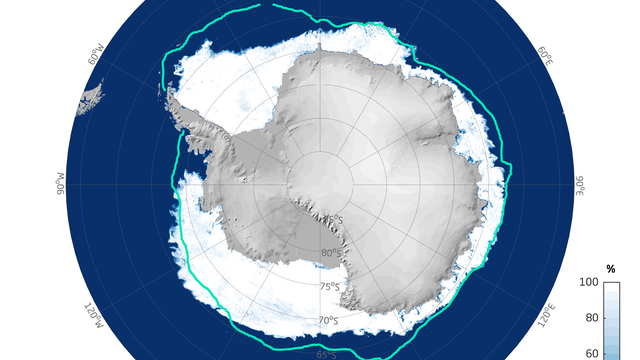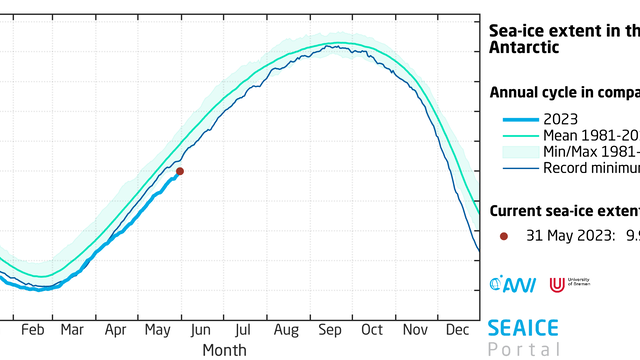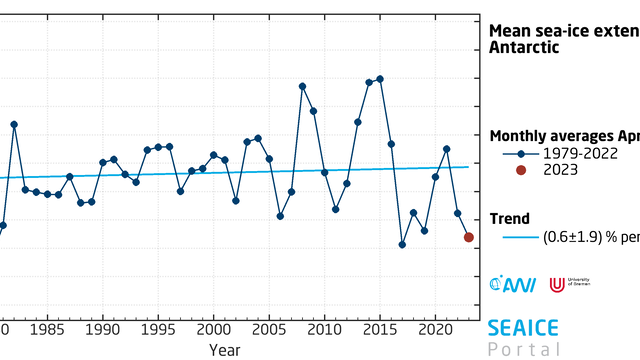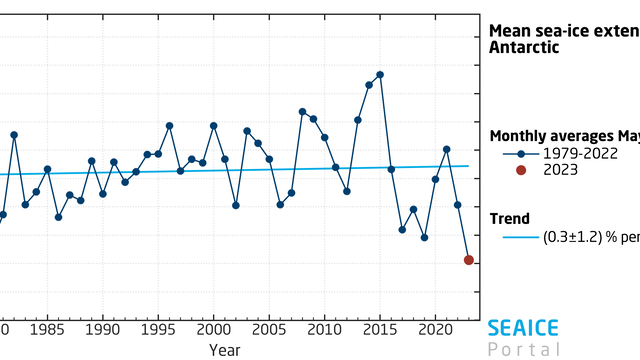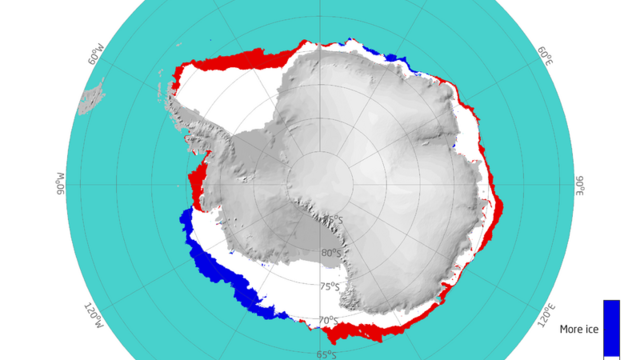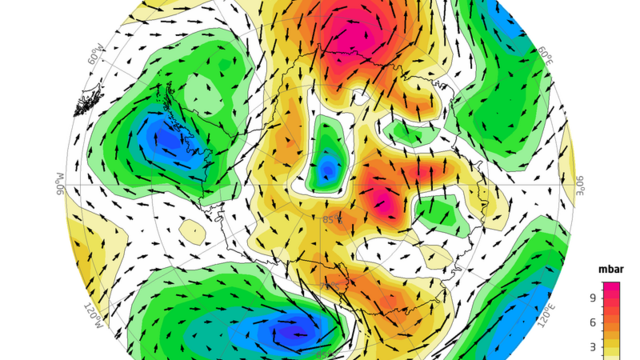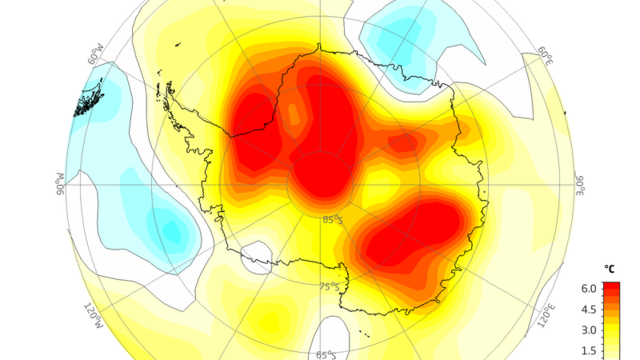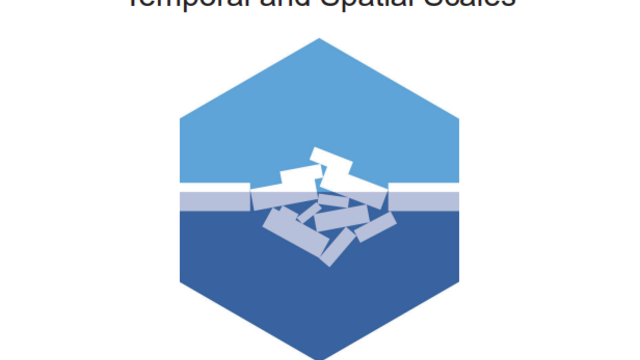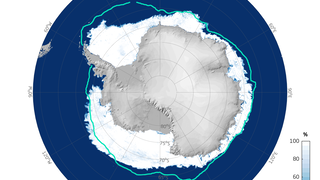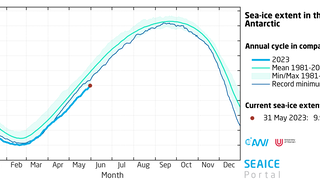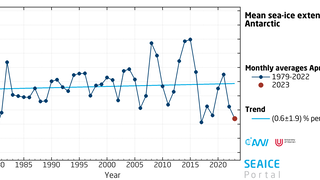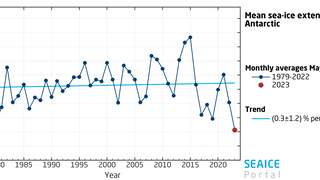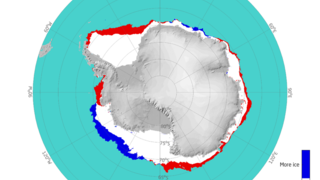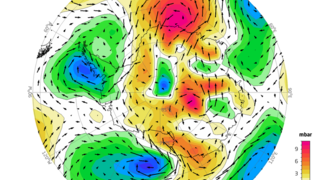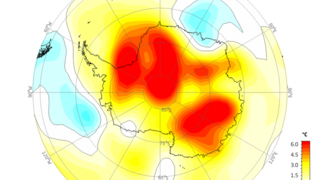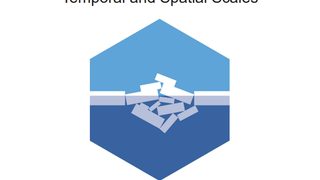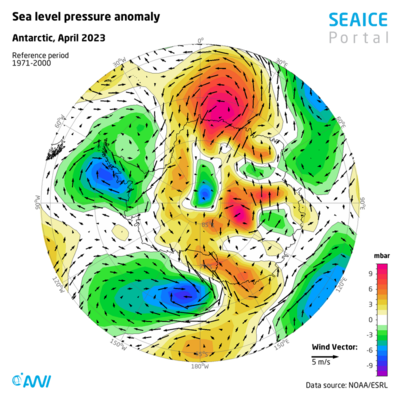After the Antarctic sea-ice extent reached an all-time low in February 2023, new sea ice has only slowly formed in the months since. Particularly in the Bellingshausen Sea, uncharacteristically for this time of year, there is very little new sea ice, preventing the formation of contiguous ice cover – pack ice (Figure 1). The Antarctic sea-ice extent was only 9.99 million km² (Figure 2) on 31 May 2023, putting it between 136,000 km² and 590,000 km² below the previous lowest extents on the same date, from the years 1986 and 2019. Since mid-April, the ice extent has remained below the levels seen in these comparison years. In March and April, the ice extent in the Antarctic continued the low levels of the previous months and, at mean values of 3.12 million km² in March and 5.69 million km² in April (Figure 3), dropped to the third-lowest ice extent respectively. In May, the monthly mean ice extent was only 8.51 million km², 306,000 km² below the previous low from 1980 (Figure 4). In other words, about an additional area the size of Poland (312,685 km²) was ice-free.
The regions in which significantly less ice has formed than in the previous year / the long-term average for past years are mainly concentrated in the Bellingshausen Sea and Weddell Sea, but also cover broad expanses of Antarctica’s eastern coastline. The western Ross Sea is the only place where a larger belt of pack ice formed than in the previous year (Figure 5). This unusual development is most likely connected to a pronounced low-pressure cell (Figures 6 and 7) that manifested to the west of the Antarctic Peninsula in the Amundsen and Bellingshausen Seas and, thanks to its cyclonic (i.e., clockwise in the Southern Hemisphere) rotation, is driving air masses and drifting ice away from the Antarctic Peninsula and into the open ocean. At the same time, warm air masses are being transported in from the north / northeast, slowing ice formation in the region. Temperatures over the Antarctic inland ice are currently more than 6° C higher than the long-term average for the years 1971 – 2000. In a study conducted this February, Wang et al. (2023) investigated the effects of a more intensive low-pressure system over the Amundsen Sea on the lowest Antarctic sea-ice minimum to that point in time (from the spring of 2022) and identified a clear connection between the processes. A similar set of circumstances arose this spring, producing even more intensive sea-ice retreat. Consequently, the month of May showed a new low in ice extent for the time of year. However, the further development of the Antarctic sea ice in the course of the Antarctic winter can’t yet be predicted.
From 4 – 9 June 2023, Bremerhaven will host the International Glaciological Society’s international sea-ice symposium “Sea Ice Across Temporal and Spatial Scales”, which will be jointly organised by the Alfred Wegener Institute, Helmholtz Centre for Polar and Marine Research, and the University of Bremen. The symposium, the largest of its kind, is held in a different country every five years. The six-day event will bring together ca. 280 sea-ice experts from 20 countries to discuss the state of the art in sea-ice research, the outcomes of the MOSAiC expedition, and the rapidly changing sea-ice conditions in the Antarctic. Dr Marcel Nicolaus, a sea-ice physicist at the AWI and co-organiser of the symposium, can hardly wait: “I’m very pleased that our conference will bring so many of our peers from around the world to Bremerhaven. It’s like a huge ‘class reunion’ with many of our friends. We will review and discuss the outcomes of various projects. One focus will be on assessing a range of observations and modelling results from and on the Arctic, and on discussing what we should expect to see there in the years to come. But the conference will also consider the dramatic sea-ice trends in the Antarctic. We will also tackle the question of whether, and if so, to what extent climate change has reached the Antarctic, which was unaffected for many years.”
References
Wang, S., et al 2023: Contribution of the deepened Amundsen sea low to the record low Antarctic sea ice extent in February 2022, Environ. Res. Lett. 18 054002 DOI 10.1088/1748-9326/acc9d6, iopscience.iop.org/article/10.1088/1748-9326/acc9d6
Contact
Questions?
Contact us by E-Mail or use our contact form.
Graphics
